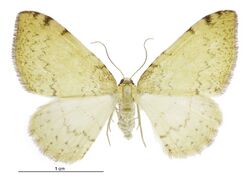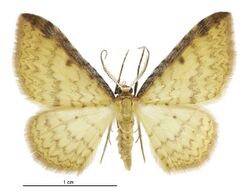Biology:Epiphryne undosata
| Epiphryne undosata | |
|---|---|

| |
| Female | |

| |
| Male | |
| Scientific classification | |
| Kingdom: | |
| Phylum: | |
| Class: | |
| Order: | |
| Family: | |
| Genus: | |
| Species: | E. undosata
|
| Binomial name | |
| Epiphryne undosata (Felder & Rogenhofer, 1875)[1]
| |
| Synonyms[2] | |
| |
Epiphryne undosata, also known as the lacebark looper, is a moth of the family Geometridae.[1] It is endemic to New Zealand and is found on both the North and South Islands. It inhabits native forest. The larvae feed on plant species in the genera Hoheria and Plagianthus. They pupate amongst dead leaves in a silk cocoon. The adult moths have been observed on the wing all year round but are most commonly seen from November until February. The adult moths are extremely variable in both their colour intensity and wing pattern.
Taxonomy
This species was first described by Baron Cajetan von Felder, Rudolf Felder and Alois Friedrich Rogenhofer in 1875 using a specimen collected in Nelson by T. R. Oxley and named Cidaria undosata.[3] In 1884 Edward Meyrick placed this species in the genus Epiphryne.[4] However George Hudson discussed and illustrated this species in both 1898 and 1828 under the name Venusia undosata.[5][6] In 1988 J. S. Dugdale discussed this species under the name Epiphryne undosata.[2] The syntype is held at the Natural History Museum, London.[2]
Description
Hudson described the larva of this species as follows:
slightly over 1⁄2 inch in length, rather stout, green, paler underneath, with the skin slightly wrinkled; the head is ochreous; there is a broad dull crimson dorsal line containing a central black bar on each segment; two or three rows of conspicuous black warts emitting short black bristles, and a very indistinct greyish lateral line.[6]
Robert Hoare pointed out that white stripe along the back of the larva helps camouflage it as it resembles the leaf vein on the leaves on some of its host plants.[7]
Hudson described the adult of the species as follows:
The expansion of the wings is hardly an inch. All the wings arc pale yellow with a variable number of fine jagged reddish-brown transverse lines, which are usually most distinct towards the termen. The fore-wings have a broad band of reddish-brown along the costal edge ; a blackish dot above the middle just touching the costal band, and a small brown mark near the apex. The hind-wings have a minute black dot a little above the middle.[5]
The adult moths are variable in both colour intensity and pattern.[6]
Distribution
This species is endemic to New Zealand.[8][9] It can be found in both the North and South Islands.[6] It is regarded as being locally common.[7]
Habitat
This species inhabits native forest, particularly riverine forest, and has been observed in numbers near lace-bark trees.[7][5][6] It has also been observed Kunzea ericoides forest.[10]
Life history and behaviour
The eggs of this species are greenish in colour and hatch after approximately two weeks.[11] Larvae are active and feed on the leaves and seeds of their host plants during the New Zealand spring and summer.[7][6] The larvae pupate amongst dead leaves with the pupa being enclosed in a delicate silken cocoon.[6] Adults have been observed on the wing all year but can be seen most commonly from November until February.[6] The adults are nocturnal, are attracted to light and have been collected via light traps.[7][12]
Host plants and parasites
Larval host plants of this species include Hoheria glabrata, Hoheria populnea, Hoheria sexstylosa, Plagianthus regius, and Plagianthus betulinus.[13][6] Adult E. undosata feed from the flowers and assist with the pollination of Dracophyllum acerosum, Hoheria lyallii, and Veronica salicifolia.[13][14] The larvae of E. undosata have been parasitised by the wasp Meteorus pulchricornis.[15]
Conservation status
This species is regarded as "not threatened".[16]
References
- ↑ 1.0 1.1 "Epiphryne undosata (Felder & Rogenhofer, 1875) - Biota of NZ". https://biotanz.landcareresearch.co.nz/scientific-names/bafa6ff9-85d8-46c5-a0d7-a7becf27188a.
- ↑ 2.0 2.1 2.2 , pp. 179, Wikidata Q45083134
- ↑ von Felder, Baron Cajetan; Felder, Rudolf; Rogenhofer, Alois Friedrich (1875). "Lepidoptera" (in en). Reise der österreichischen Fregatte Novara um die Erde. (Zoologischer Theil.) pt.9:Bd.2:Abt.2 Atlas: pl. CXXVIII, Fig 2. https://biodiversitylibrary.org/page/1221197.
- ↑ , pp. 60, Wikidata Q109615359
- ↑ 5.0 5.1 5.2 , pp. 54, Wikidata Q19073637
- ↑ 6.0 6.1 6.2 6.3 6.4 6.5 6.6 6.7 6.8 , pp. 106, Wikidata Q58593286
- ↑ 7.0 7.1 7.2 7.3 7.4 , pp. 93, Wikidata Q59396160
- ↑ "Cidaria undosata Felder & Rogenhofer, 1875". Landcare Research New Zealand Ltd. http://www.nzor.org.nz/names/e39198cd-6ba7-43a6-8dcf-a00755c7eb6e.
- ↑ , pp. 459, Wikidata Q45922947
- ↑ Dugdale, John; Hutcheson, John. "Invertebrate values of kanuka (Kunzea ericoides) stands, Gisborne Region". Science for Conservation 55: Appendices. https://www.doc.govt.nz/globalassets/documents/science-and-technical/sfc055a.pdf.
- ↑ , pp. 129-130, Wikidata Q115000559
- ↑ Patrrick, B. H.; Archibald, R. D. (January 1988). "Lepidoptera light-trapped at Owaka, South Otago" (in en). New Zealand Entomologist 11 (1): 70–72. doi:10.1080/00779962.1988.9722541. ISSN 0077-9962. http://www.tandfonline.com/doi/abs/10.1080/00779962.1988.9722541.
- ↑ 13.0 13.1 "Epiphryne undosata (Felder & Rogenhofer, 1875)". 2011. https://plant-synz.landcareresearch.co.nz/DetailsForm.aspx?Type=H&RecordId=1541&LSID=NAM51539.
- ↑ Primack, Richard B. (1983-07-01). "Insect pollination in the New Zealand mountain flora". New Zealand Journal of Botany 21 (3): 317–333. doi:10.1080/0028825x.1983.10428561. ISSN 0028-825X.
- ↑ "Factsheet: Basket-cocoon parasitoid - Meteorus pulchricornis". https://nzacfactsheets.landcareresearch.co.nz/factsheet/InterestingInsects/Basket-cocoon-parasitoid---Meteorus-pulchricornis.html.
- ↑ "Oceana Gold New Zealand Limited Consent Application Part 2". 22 December 2016. https://www.orc.govt.nz/media/8437/oceana-gold-new-zealand-limited-consent-application-part-2.pdf.
Wikidata ☰ Q13546763 entry
 |




